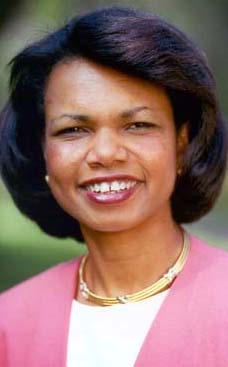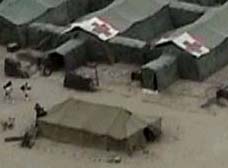2006.03.13: March 13, 2006: Headlines: Figures: COS - Nepal: Politics: Congress: SUNY-ESF Headlines: The SUNY College of Environmental Science and Forestry hosts James Walsh
Peace Corps Online:
Directory:
Nepal:
RPCV James Walsh (Nepal) :
Special Report: RPCV Congressman James Walsh:
2006.03.13: March 13, 2006: Headlines: Figures: COS - Nepal: Politics: Congress: SUNY-ESF Headlines: The SUNY College of Environmental Science and Forestry hosts James Walsh
The SUNY College of Environmental Science and Forestry hosts James Walsh
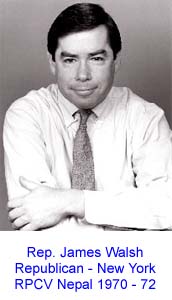
Since 1995, Congressman Walsh has used his position on the House Appropriations Committee to leverage $4.2 million for SUNY-ESF's woody biomass project, $1.5 million to begin the Lake Ontario water-cooling study, and over $29 million to support SUNY-ESF's Center for Sustainable and Renewable Energy and the Center of Excellence in Environmental Systems. Congressman James Walsh of New York served as a Peace Corps Volunteer in Nepal in the 1960's.
The SUNY College of Environmental Science and Forestry hosts James Walsh
ESF Hosts Congressmen James Walsh and Charles Bass
Joined by area business leaders for the latest on development of a biorefinery in New York State
3/13
(Syracuse, NY) – The SUNY College of Environmental Science and Forestry (ESF) updated and demonstrated the latest efforts to go commercial with the extraction and production of ethanol from mixed northern hardwood with a day long tour on Monday, March 13, 2006.
Congressman James Walsh (NY, 25th) and Congressman Charles Bass (NH, 2nd), accompanied by a delegation of industry and business leaders, attended demonstrations of newly installed, commercial capacity equipment on the ESF campus and heard from members of the research team including Jim Nakas, Tom Amidon and Tim Volk.
Participants also heard from the developers of Northeast Biofuels LLC, an independent plan to convert the former Miller Brewery in Fulton into a major ethanol refinery first using corn and later using wood as a feedstock. They hope to begin retooling for ethanol production by this summer.
“We wanted Congressman Walsh to understand that his faith in ESF is well-placed. Because of his strong support, we are less than two years away from delivering tree-based ethanol to the marketplace,” said Cornelius B. Murphy, Jr., president, of SUNY-ESF.
“We also recognize that Congressman Bass, as a member of the House Energy and Commerce Committee, led the effort to ensure woody biomass was properly included in the Energy Bill among the renewable energy feed stocks and that projects like the Biorefinery in New York received fair consideration. We welcomed his participation in the tour with the expectation that what’s happening here can be applied throughout the northeastern forests,” continued Murphy.
"There has been growing interest in the development of renewable energy sources over the past few years," said Rep. Jim Walsh (NY-25). "It's important to note that SUNY-ESF has been researching and developing the use of woody biomass as an alternative energy source since the mid 1990's. Together with the Center of Excellence and our chilled water cooling initiative, Central New York is poised to become a leader in this growing field of research."
Since 1995, Congressman Walsh has used his position on the House Appropriations Committee to leverage $4.2 million for SUNY-ESF's woody biomass project, $1.5 million to begin the Lake Ontario water-cooling study, and over $29 million to support SUNY-ESF's Center for Sustainable and Renewable Energy and the Center of Excellence in Environmental Systems.
"The hard work and research being done at SUNY-ESF demonstrates that the federal attention being paid to wood and other cellulosic energy research and development is sound. National and regional energy security requires that we explore and develop the resources of the Northern Forest in a sustainable manner. Transportation fuel has been a major problem for most alternate energy sources, which is why the work being done here is so critical," said Bass.
"Congressman Jim Walsh and I have been working together chasing different ends of the federal tail, and I think we've now caught it just about right," continued Bass.
SUNY-ESF has invented a method of removing energy-rich sugars from wood that leaves the cellulose, which becomes pulp, for use in making paper and the lignin for energy recovery. Also extracted is the wood’s acetic acid that is used in manufacturing.
Ordinary wood chips are mixed with water and heated at high temperatures for a specific length of time. Water is the only solvent used. The watery solution that remains after the chips are removed is then forced through a membrane that separates the acetic acid and sugars.
Commercial testing of the process is underway now that a 70-cubic foot digester has been built and a 400-liter fermenter installed in SUNY-ESF’s Walters Hall.
When this story was posted in March 2006, this was on the front page of PCOL:





Peace Corps Online The Independent News Forum serving Returned Peace Corps Volunteers
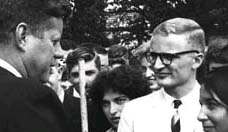 | History of the Peace Corps
PCOL is proud to announce that Phase One of the "History of the Peace Corps" is now available online. This installment includes over 5,000 pages of primary source documents from the archives of the Peace Corps including every issue of "Peace Corps News," "Peace Corps Times," "Peace Corps Volunteer," "Action Update," and every annual report of the Peace Corps to Congress since 1961. "Ask Not" is an ongoing project. Read how you can help. |
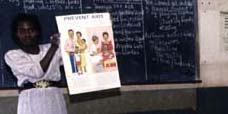 | The Peace Corps Library
The Peace Corps Library is now available online with over 40,000 index entries in 500 categories. Looking for a Returned Volunteer? Check our RPCV Directory. New: Sign up to receive PCOL Magazine, our free Monthly Magazine by email. Like to keep up with Peace Corps news as it happens? Sign up to recieve a daily summary of Peace Corps stories from around the world. |
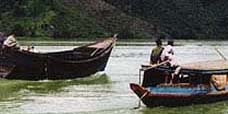 | Peace Corps suspends program in Bangladesh
Peace Corps Director Gaddi H. Vasquez announced the suspension of the Peace Corps program in Bangladesh on March 15. The safety and security of volunteers is the number one priority of the Peace Corps. Therefore, all Peace Corps volunteers serving in Bangladesh have safely left the country. More than 280 Peace Corps volunteers have served in Bangladesh since the program opened in November 1998. Latest: What other newspapers say. |
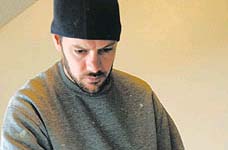 | Invitee re-assigned after inflammatory remarks
The Peace Corps has pulled the invitation to Derek Volkart to join the Morocco Training Program and offered him a position in the Pacific instead after officials read an article in which he stated that his decision to join the Peace Corps was in "response to our current fascist government." RPCV Lew Nash says that "If Derek Volkart spoke his mind as freely in Morocco about the Moroccan monarchy it could cause major problems for himself and other Peace Corps volunteers." Latest: The Ashland Daily Tidings has issued a request for all Peace Corps communications on the case. |
 | Re-envision Peace Corps
Nicholas J. Slabbert says in his article in the Harvard International Review that an imaginatively reinvented Peace Corps could powerfully promote US interests in a period when perceptions of American motives are increasingly relevant to global realignment. His study envisions a new role for the Peace Corps in five linked areas: (1) reinventing America's international profile via a new use of soft power; (2) moving from a war-defined, non-technological, reactive theory of peace to a theory of peace as a normal, proactive component of technologically advanced democracy; (3) reappraising Peace Corps as a national strategic asset whose value remains largely untapped; (4) Peace Corps as a model for the technological reinvention of government agencies for the 21st century; (5) redefining civil society as information technology society. Read the article and leave your comments. |
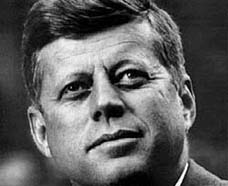 | March 1, 1961: Keeping Kennedy's Promise
On March 1, 1961, President John F. Kennedy issues Executive Order #10924, establishing the Peace Corps as a new agency: "Life in the Peace Corps will not be easy. There will be no salary and allowances will be at a level sufficient only to maintain health and meet basic needs. Men and women will be expected to work and live alongside the nationals of the country in which they are stationed--doing the same work, eating the same food, talking the same language. But if the life will not be easy, it will be rich and satisfying. For every young American who participates in the Peace Corps--who works in a foreign land--will know that he or she is sharing in the great common task of bringing to man that decent way of life which is the foundation of freedom and a condition of peace. " |
 | Paid Vacations in the Third World?
Retired diplomat Peter Rice has written a letter to the Wall Street Journal stating that Peace Corps "is really just a U.S. government program for paid vacations in the Third World." Director Vasquez has responded that "the small stipend volunteers receive during their two years of service is more than returned in the understanding fostered in communities throughout the world and here at home." What do RPCVs think? |
 | RPCV admits to abuse while in Peace Corps
Timothy Ronald Obert has pleaded guilty to sexually abusing a minor in Costa Rica while serving there as a Peace Corps volunteer. "The Peace Corps has a zero tolerance policy for misconduct that violates the law or standards of conduct established by the Peace Corps," said Peace Corps Director Gaddi H. Vasquez. Could inadequate screening have been partly to blame? Mr. Obert's resume, which he had submitted to the Peace Corps in support of his application to become a Peace Corps Volunteer, showed that he had repeatedly sought and obtained positions working with underprivileged children. Read what RPCVs have to say about this case. |
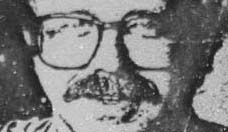 | Why blurring the lines puts PCVs in danger
When the National Call to Service legislation was amended to include Peace Corps in December of 2002, this country had not yet invaded Iraq and was not in prolonged military engagement in the Middle East, as it is now. Read the story of how one volunteer spent three years in captivity from 1976 to 1980 as the hostage of a insurrection group in Colombia in Joanne Marie Roll's op-ed on why this legislation may put soldier/PCVs in the same kind of danger. Latest: Read the ongoing dialog on the subject. |
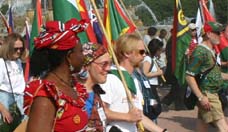 | Friends of the Peace Corps 170,000 strong
170,000 is a very special number for the RPCV community - it's the number of Volunteers who have served in the Peace Corps since 1961. It's also a number that is very special to us because March is the first month since our founding in January, 2001 that our readership has exceeded 170,000. And while we know that not everyone who comes to this site is an RPCV, they are all "Friends of the Peace Corps." Thanks everybody for making PCOL your source of news for the Returned Volunteer community. |
Read the stories and leave your comments.

Some postings on Peace Corps Online are provided to the individual members of this group without permission of the copyright owner for the non-profit purposes of criticism, comment, education, scholarship, and research under the "Fair Use" provisions of U.S. Government copyright laws and they may not be distributed further without permission of the copyright owner. Peace Corps Online does not vouch for the accuracy of the content of the postings, which is the sole responsibility of the copyright holder.
Story Source: SUNY-ESF Headlines
This story has been posted in the following forums: : Headlines; Figures; COS - Nepal; Politics; Congress
PCOL32169
97












